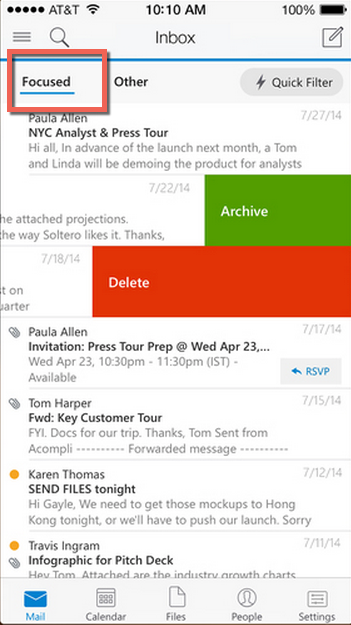Gmail, Outlook Apps Build A Better Email Marketing Ecosystem
Despite concerns, mobile email app usage doesn't decrease engagement, columnist Kevin Gallant says.
With more than 50 percent of email users now opening emails on mobile devices, it’s no wonder major email providers like Gmail and Outlook are continuously launching new mobile apps and upgrades to make reading, writing and organizing emails easier on the go.
Outlook recently launched its new mobile application for iOS and Android in an effort to be the primary, all-encompassing email app for users on the two largest mobile software platforms. Gmail has continued to revolutionize the email industry by releasing the app Inbox, giving users more power over the organization of their email and daily schedule. Both apps directly compete with the native “Mail” app on iOS and other similar apps on Android.
Despite the obvious benefits these apps have for daily email users, most email marketers have valid concerns about deliverability. But if you look closely, the Gmail and Outlook apps do not actually spell doom for email marketers.
Why Marketers Are Concerned
Most marketers’ primary concern with new technology or an application change is fear that it will negatively impact email marketing programs.
Updates like Gmail’s “promotions” tab, Outlook’s “focused” and “other” folders, or the new pinning and bundling features on Gmail’s mobile app tend to make marketers believe they’ll have to change their entire email-marketing strategy. Many feel that these updates will make it even easier for consumers to avoid ever opening a marketing email.
And this concern is not without reason. Mobile email opens and clicks have fluctuated over the years, but as of the fourth quarter of 2014, mobile email opens are on the rise. Yesmail’s quarterly email benchmark report for the period found that mobile clicks account for almost 40 percent of all email clicks, largely due to responsive design. (Disclosure: I work for Yesmail.)
Positive Deliverability
Along with the increase in email clicks, mobile conversion rates (purchase resulting from an email click) grew 70 percent in the fourth quarter of 2014. Despite valid concerns, marketers should instead be pleased that both Google and Outlook are creating apps to make life easier for mobile email users.
Yesmail found that updates like the Gmail app’s snooze, pin and bundling features had very little impact on open rates themselves. These updates actually will likely pose many benefits for marketers.
First, the app’s overall look and feel make opening an email easier than ever. Furthermore, when consumers snooze an email, Gmail’s app can remind them about it when they reach a certain place, which provides an opportunity for marketers to offer real-time, in-store offers.
Lastly, anytime a consumer receives an email in the predetermined or custom-built bundles, that bundle will jump to the top of inbox with all emails in that group easily identified.
Similarly, Outlook’s app is likely to have some benefits for marketers. Outlook’s “focused” and “other” folders are designed to be smart in that they group messages based on how often users interact with the sender. So, if a user is opening and clicking through emails from a certain marketer more often, those messages are likely to end up classified as “focused” rather than “other.”

Outlook’s “Focused” tab
More broadly, these apps will help marketers get more out of their active audience and keep them active. It’s now easier than ever for an ISP to determine if a user is not seeing your emails or is simply not interested.
As a result, marketers can learn more about their audience by being more active. Cleaner lists mean better data, and less guessing with older lapsed users means less deliverability implications.
A Better Ecosystem
Aside from offering benefits for both users and marketers when it comes to ease of use and deliverability, mobile email apps like those created by Gmail and Outlook are actually helping build a better overall ecosystem for marketers, ISPs and their mutual subscribers by encouraging two best practices:
• Responsive templates: The ISP applications have shown they were developed to coincide with the main points of interest of how they score engagement.
The apps are making it easier to understand when a subscriber is truly not engaged in the emails, which helps make the user experience better for both ISPs and subscribers. Because of this, marketers can better determine which customers are engaged and when, and personalize emails accordingly.
• Monitor mobile rendering: If an email doesn’t load well at the time a subscriber wants to engage with a brand, marketers are lessening their chances of that subscriber opening again. This will hurt the consumer experience and overall deliverability.
There’s a positive cycle in email opens, and that’s likely because marketers are applying responsive design.
On April 21, Google will include mobile-friendliness as a ranking signal, emphasizing the mobile takeover. This change — along with updates to Google and Outlook apps — proves the growing role mobile is playing in marketing, and it’s just one of the many reasons to adapt to the new email-marketing ecosystem.
Incorporating responsive design will help marketers reach their audience where and when they want to be met.
Contributing authors are invited to create content for MarTech and are chosen for their expertise and contribution to the martech community. Our contributors work under the oversight of the editorial staff and contributions are checked for quality and relevance to our readers. The opinions they express are their own.
Related stories
